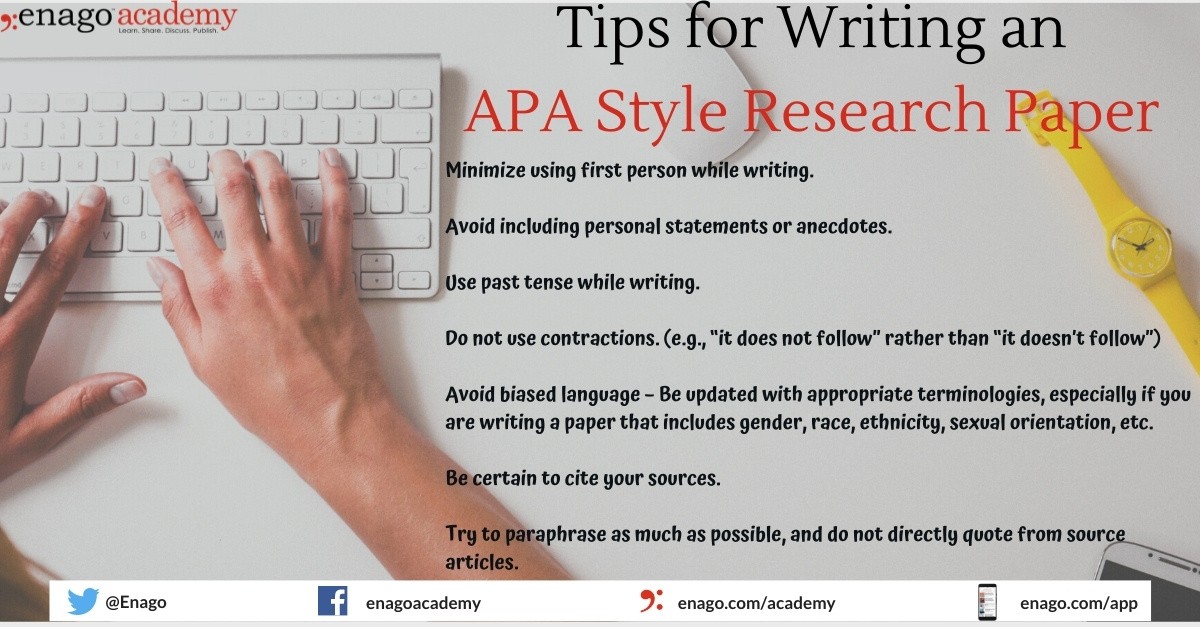How to Write a Research Paper in APA Format — A Complete Guide

Completed your research experiments and collated your results? Does it feel like you have crossed a major hurdle in your research journey? No, not even close! What lies next is — publishing your research work for it to reach the science world! The process of publishing a research paper is so intricate, if you miss one aspect, you could end up struggling with revisions and reworks or getting a rejection! Thus, there is a necessity of following an exceptional mode of writing. The APA style research format comes to a researcher’s rescue.
This article discusses how to effortlessly write an APA style research paper and how it is necessary to understand the basic elements of APA style research paper in order to write an article in APA style research format.
What Is APA Style?
The APA format is the official style of American Psychological Association (APA) and is commonly used to cite sources in psychology, education and social sciences. APA research paper format is widely used in the research publishing industry.
Students and researchers usually get confused with various research paper writing formats and are unclear about the requirements from the research publication journals. Therefore, the best way to deal with beginning to write a research paper is to first know the journal’s requirement and then follow the guidelines accordingly.
Though the reference section may change over the course of time, the information related to the other sections in APA research paper format is similar and could be referred to, for writing an exemplary research paper.
Guidelines for APA Style Paper (7th edition)
An APA style research format is different as compared to a term paper, a creative writing paper, a composition-style paper, or a thought paper. Throughout the paper you need to apply these guidelines while writing the paper –
-
Page Layout:
Type the content and keep double-space on standard-sized paper (8.5” x 11”), with 1” margins on all sides.
You should indent the first line of every paragraph 0.5 inches
Include a page number on every page.
-
Font:
You could use an accessible font like Times New Roman 12pt., Arial 11pt., or Georgia 11pt.
APA Research Paper Sections
The APA research paper format is based on seven main components: title page, abstract, introduction, methods, results, discussion, and references. The sections in APA-style paper are as follows:
1. Title Page
As per the APA research paper format, the title should be between 10-12 words and should reflect the essence of the paper. After writing the title, write your name followed by name of the college. Furthermore, create a page header using the “View Header” function in MS Word and on the title page include a running head — a short title that appears at the top of pages of published articles (flush left) and page number on the same line (flush right). The running head should not exceed 50 characters, including punctuation and spacing. Moreover, you could use the toolbox to insert a page number, so that it automatically numbers each page.
 APA Style – Student Paper in APA 7 Style
APA Style – Student Paper in APA 7 Style
 APA Style – Professional Paper in APA 7 Style
APA Style – Professional Paper in APA 7 Style
2. Abstract
Abstract should contain no more than 120 words, and should be one paragraph written in block format with double spacing. Additionally, state the topic in a sentence or two. Also, provide overview of methods, results, and discussion.

APA Style – Abstract in APA Style
3. Introduction
An introduction of APA research paper format is the most difficult section to write. A good introduction critically evaluates the empirical knowledge in the relevant area(s) in a way that defines the knowledge gap and expresses your aim for your study and why you conducted it. However, the challenge here is to keep the reader’s interest in reading your paper.
A good introduction keeps readers engaged with your paper. For writing an interesting introduction, researchers should introduce logical flow of ideas which will eventually lead to the research hypothesis. Furthermore, while incorporating references into your introduction, do not describe every single study in complete detail. Summarize the key findings from the article and do not quote from the articles, instead paraphrase the content.
4. Methods
The method section in APA research paper format is straightforward. However, the protocol and requirements should be mentioned precisely. The goal of this section is to describe your study and experiments in detail, so that there is no issue in reproducibility of results and other researchers could duplicate your methods effectively.
This section includes Materials and/or Apparatus and Experiments/Procedures/Protocols. Furthermore, keep the procedures brief and accurate, and make sure to read through so as to not repeat the steps or avoid redundancy.
5. Results
In this section, you could describe how you analyzed the data and explain your findings. If your data analyses are complex, then break the section into subsections, ideally a subsection for each hypothesis and elaborate the subsections by using statistical analysis and including tables or figures to represent results visually. Most importantly, do not share interpretation of the results here. You can interpret and explain the results in the discussion section.
6. Discussion
Results are interpreted and understood in this section. Discussion section helps understand the research hypothesis better and places the results in the broader context of the literature in the area. This section is the reversal of introduction section, wherein you begin with the specifics and explain the general understanding of the topics.
In discussion, you start with a brief of your main findings, followed by explaining if your research findings support your hypothesis. Furthermore, you could explain how your findings enhance or support the existing literature on the topic. Connect your results with some of the literature mentioned in the introduction to bring your story back to full circle. You could also mention if there are any interesting or surprising findings in your results. Discuss other theories which could help you justify your surprising results.
Explain the limitation of your study and mention all the additional questions that were generated from your study. You could also mention what further research should be conducted on the topic and what are the knowledge gaps in the current body of research. Finally, mention how your results could relate to the larger issues of human existence and highlight “the big picture” for your readers.
7. References
Provide an alphabetical listing of the references. Do not keep extra spaces between references and double-space all the references. The second line of each reference should be intended. You could refer to the examples (mentioned below) to know how to format references correctly.
I. Journal Article:
Only first letter of the first word of the article title is capitalized; the journal name and volume are italicized. If the journal name had multiple words, each of the major words are capitalized.
Example: Ebner-Priemer, U. W., & Trull, T. J. (2009). Ecological momentary assessment of mood disorders and mood dysregulation. Psychological Assessment, 21, 463-475. doi:10.1037/a0017075
II. Book Chapter:
Only the first letter of the first word of both the chapter title and book title are capitalized.
Example: Stephan, W. G. (1985). Intergroup relations. In G. Lindzey & E. Aronson (Eds.), The handbook of social psychology (3rd ed., Vol. 2, pp. 599-658). New York: Random House.
III. Book:
Example: Gray, P. (2010). Psychology (6th ed.). New York: Worth
IV. Table:
There are various formats for tables, depending upon the information you wish to include. So, be thorough and provide a table number and title (the latter should be italicized). Tables can be single or double-spaced.
V. Figure:
Be sure to mention x- and y-axes clearly. Underneath the figure provide a label and brief caption. The figure caption typically includes variables and units of measurements. Also, include error bars in your bar graphs, and note what the bars represent in the figure caption – Error bars represent one standard error above and below the mean.
VI. In-Text Citation:
- Mention the authors’ names and publication date while citing sources in your paper.
- When including the citation as part of the sentence, use AND: “According to Jones and Smith (2003), the…”
- When the citation is written in parentheses, use &: “Studies have shown that priming can affect actual motor behavior (Jones & Smith, 2003; Kiley, Bailey, & Hammer, 1999). The studies in parentheses should appear alphabetically by first author’s last name, and separate it with semicolons.
- You should avoid quoting directly, but in case you do – along with the name and date, include the page number.
- For sources with three or more authors, once you have listed all the authors’ names, you may write “et al.” on subsequent mentions: “Klein et al. (1999) found that…”.
- Meanwhile, when source has six or more authors, the first author’s last name and “et al.” are used every time the source is cited.
VII. Secondary Source:
It is a term used to describe material that is cited in another source. Avoid using secondary sources in your papers. Try to find the primary source and read it before citing in your work. However, if you must mention a secondary source, refer to the APA style paper example below:
Primary source author’s last name (as cited in secondary source author’s last name, year) argued that…
7 Tips for Writing an Error-free APA Style Research Paper

- Although there are exceptions, minimize using first person while writing.
- Avoid including personal statements or anecdotes.
- Although there are exceptions, use past tense while writing.
- Do not use contractions. (e.g., “it does not follow” rather than “it doesn’t follow”)
- Avoid biased language – Be updated with appropriate terminologies, especially if you are writing a paper that includes gender, race, ethnicity, sexual orientation, etc.
- Be certain to cite your sources.
- Try to paraphrase as much as possible, and do not directly quote from source articles.
This article contains only a few aspects of an APA research paper format. There are many APA style rules which can be explored before you begin to write an APA style research paper. Many of the APA research paper format rules are dynamic and subject to change, so it is best to refer to 7th edition (latest) of the APA Publication Manual and be thorough with every section’s format before writing a research paper.
Have you used an APA research paper format to write your article? Do write to us or comment below and tell us how your experience writing an APA style paper was?
Frequently Asked Questions
The APA format is the official style of American Psychological Association (APA) and is commonly used to cite sources in psychology, education and social sciences.
APA stands for the American Psychological Association. It is a professional organization that focuses on the field of psychology and related disciplines.
Citing sources in APA format involves specific guidelines for different types of sources.
In-text Citations: For a paraphrased or summarized idea from a source, include the author's last name and the publication year in parentheses.
Example: (Smith, 2021) Reference List Entry for a Journal Article:
Only first letter of the first word of the article title is capitalized; the journal name and volume are italicized. If the journal name had multiple words, each of the major words are capitalized.
Example: Ebner-Priemer, U. W., & Trull, T. J. (2009). Ecological momentary assessment of mood disorders and mood dysregulation. Psychological Assessment, 21, 463-475. doi:10.1037/a0017075
The APA (American Psychological Association) style is primarily used by researchers, scholars, and students in the social sciences, including psychology, sociology, education, and related fields. However, the APA style is not limited to these disciplines and is also used in other academic and scientific fields when writing research papers or scholarly articles.
As per the 7th edition of APA citation (published in 2020), the last name and first/middle initials for all authors (up to first 20 authors) are mentioned in the bibliography. If there are 21 or more authors, an ellipsis (but no ampersand) is used after the 19th author, and then the final author’s name is added.
Generic format: Author, A. A., Author, B. B., & Author, C. C. (Year). Title of article. Title of Journal, Volume # (issue number), Pages. https://doi.org/xx.xxx/yyyy
Example: Ebner-Priemer, U. W., & Trull, T. J. (2009). Ecological momentary assessment of mood disorders and mood dysregulation. Psychological Assessment, 21, 463-475. doi:10.1037/a0017075
When quoting in APA format, you need to properly incorporate and cite direct quotations from sources.
Introduce the Quote: Begin with a signal phrase or an introductory statement to lead into the quote. This helps provide context and relevance for the quotation. Provide In-text Citation: Immediately after the closing quotation mark, include an in-text citation that provides the author's last name, publication year, and, if applicable, page number(s) of the quoted material.
Example: (Smith, 2021, p. 25) Cite the Source in the Reference List: Include a corresponding entry in the reference list for the source you are quoting. The format for the reference list entry depends on the type of source being quoted (e.g., book, journal article, website).










Good explanation given
It was really helpful. Thanks!
nice article
Neat
Perfect explanation thank you
It was really amazing perfect
very explanation, i can now make a research paper easier
very god explanation, i can now make a research paper easier
Demonstrate in APA formal and professional way thank you ! for helpful guideline